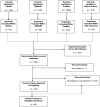A scoping review of the patient experience with wearable technology
- PMID: 39711740
- PMCID: PMC11662388
- DOI: 10.1177/20552076241308439
A scoping review of the patient experience with wearable technology
Abstract
Objective: This scoping review explores patients' experience with wearable technology. Its aims are to: (a) examine studies that contain empirical findings related to patients' experience with wearables; (b) compare these findings within and across studies; and (c) identify areas in need of greater understanding.
Methods: A Preferred Reporting Items for Scoping Review (PRISMA) guided approach was followed. Four databases of peer-reviewed articles (CINAHL, EMBASE, PubMed, and Web of Science) were searched for empirical articles involving patients' experience of using wearable technology. A standardized data abstraction form recorded relevant information on the articles identified. Data analysis included frequency counts for all abstracted categories; and itemized (by study) findings related to patients' wearable experience including satisfaction.
Results: Forty-six studies comprised the final review sample. The research literature examining patients' wearable experience is characterized by variety in terms of sample sizes, medical situations and wearable devices examined, research settings, and geographic location. This literature supports a positive patient experience with wearables in terms of satisfaction and usability, although the evidence is mixed when it comes to comfort. The moderate to higher satisfaction, usability, and comfort findings across studies do not suggest any sort of pattern with respect to the type of wearable, medical situation, or location.
Conclusions: The review findings suggest that health care organizations should view wearable technology as a viable complement to traditional aspects of patient care. However, from a patient experience standpoint, there is still much to know and validate in this regard, especially as the technology continues to advance.
Keywords: Wearable technology; comfort; patient experience; satisfaction; usability.
© The Author(s) 2024.
Conflict of interest statement
The authors declared no potential conflicts of interest with respect to the research, authorship, and/or publication of this article.
Figures
Similar articles
-
Attributes, Methods, and Frameworks Used to Evaluate Wearables and Their Companion mHealth Apps: Scoping Review.JMIR Mhealth Uhealth. 2024 Apr 5;12:e52179. doi: 10.2196/52179. JMIR Mhealth Uhealth. 2024. PMID: 38578671 Free PMC article.
-
Beyond the black stump: rapid reviews of health research issues affecting regional, rural and remote Australia.Med J Aust. 2020 Dec;213 Suppl 11:S3-S32.e1. doi: 10.5694/mja2.50881. Med J Aust. 2020. PMID: 33314144
-
Longitudinal Coadaptation of Older Adults With Wearables and Voice-Activated Virtual Assistants: Scoping Review.J Med Internet Res. 2024 Aug 7;26:e57258. doi: 10.2196/57258. J Med Internet Res. 2024. PMID: 39110963 Free PMC article.
-
Patient acceptability of wearable vital sign monitoring technologies in the acute care setting: A systematic review.J Clin Nurs. 2019 Aug;28(15-16):2732-2744. doi: 10.1111/jocn.14893. Epub 2019 May 9. J Clin Nurs. 2019. PMID: 31017338
-
Wearing the Future-Wearables to Empower Users to Take Greater Responsibility for Their Health and Care: Scoping Review.JMIR Mhealth Uhealth. 2022 Jul 13;10(7):e35684. doi: 10.2196/35684. JMIR Mhealth Uhealth. 2022. PMID: 35830222 Free PMC article.
References
-
- Nova Advisor. U.S. Wearable Medical Devices Market. 2023. https://www.novaoneadvisor.com/report/us-wearable-medical-devices-market (accessed 22 July 2024).
-
- Goswami J. Technology Brings Care to Home for Chronically Ill Patients. 2020. https://www.healthcareitnews.com/blog/technology-brings-care-home-chroni... (accessed 22 July 2024).
-
- Vaidya A. How Connected Health Tech Bolsters Chronic Care, Behavioral Health. 2023. https://mhealthintelligence.com/features/how-connected-health-tech-bolst... (accessed 22 July 2024).
-
- Jo A, Coronel BD, Coakes CE, et al. Is there a benefit to patients using wearable devices such as fitbit or health apps on mobiles? A systematic review. Am J Med 2019; 132: 1394–1400. e1391. - PubMed
Publication types
LinkOut - more resources
Full Text Sources


